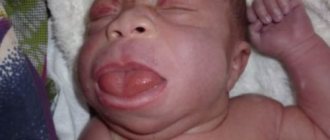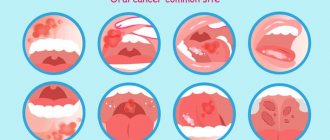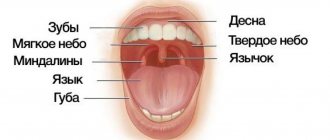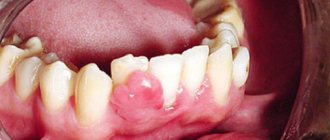We have already told the maxilla what role it plays in shaping the attractiveness of the face. If this bone is pushed up and forward, it supports the eyeballs, helps increase cheekbones, reduces the distance between the upper lip and nose, and creates a charming wide smile. What determines the correct shape and location of this “beauty bone”? As it turned out, there are two main factors: the formation of the correct (“adult”) type of swallowing and the special position of the tongue in a relaxed state, in which it affects the area of the palate located next to the front teeth of the upper jaw. Let's take a closer look at how the tongue should be positioned to move the maxilla up and forward.
Correct tongue position - why is it important?
For the correct formation of a bite and coherent speech, the correct functioning of all elements of the dental system is important.
The position of the tongue also plays an important role. Under normal conditions, the tongue should exert slight pressure on the upper row of teeth, which contributes to the formation of a correct bite in childhood. The physiological position of the tongue has the following positive effects:
- The development of the upper jaw is stimulated, both in length and width.
- Blood microcirculation in the nasopharynx area improves. This helps strengthen local immunity, which is important, in particular, for protection against respiratory infections.
- Balance improves, which is a prerequisite for the formation of correct posture.
- The normal tone of the facial muscles is maintained in a calm state.
Summary
Every person has a desire to look good, to please himself and to be attractive to others. And the mewing technique, first of all, is a set of natural habits for maintaining the proportions and oval of the face in excellent condition. And although a noticeable, tangible result may take more than one month, regular implementation and following the correct recommendations will allow you to form the correct facial features, avoid age-related sagging and make your appearance more attractive.
Tongue position - what does it affect?
The correct position of the tongue is the key to a physiological bite, as well as the absence of problems with swallowing, chewing and speech. Let's look at the main negative consequences that arise when the tongue is positioned incorrectly.
If the tongue is pushed back:
- Swallowing disorder is a disorder in the synchronization between swallowing and breathing.
- Pulling the lower jaw back.
- Dysfunction of the auditory tube.
- Violation of voice formation.
If the tongue is moved forward:
- Swallowing disorder.
- The lower jaw is pulled forward.
- Violation of voice formation.
- Curvature of teeth, especially the front ones.
- Protrusion of the tongue forward.
- Decreased lip tone (up to complete loss).
- Excessive tension transmitted to certain muscles and joints of the dental system.
Symptoms that occur due to improper tongue position include:
- violation of nasal breathing;
- swallowing disorder;
- speech defects;
- neuromotor development disorder;
- symptoms from ENT organs;
- malocclusion and other dental problems;
- dysfunction of the temporomandibular joint (TMJ);
- emotional disturbances.
First aid
If the tongue or the inside of the cheek is bitten, two problems arise at once:
1. Stop bleeding
solution: rinse your mouth with cold water, if possible, apply ice (cooling helps to constrict blood vessels)
If you cannot stop the bleeding on your own, you must immediately consult a doctor!
2. Pain relief
solution: cold also relieves pain, but if the pain is severe, treat the area with a special “freezing” spray or take a painkiller tablet
Why is the tongue positioned incorrectly?
There are several reasons that have a direct impact on the position of the tongue in the oral cavity:
- Nasal breathing disorder . This causes the tongue to move downwards. Such changes are necessary to facilitate oral breathing. Let us remember that mouth breathing, in turn, contributes to the formation of malocclusion. Therefore, parents need to closely monitor the respiratory condition of their children.
- Short bridle . In this case, the tongue is “sandwiched” by the short frenulum in a lowered position. Physically, the tongue is not able to fully press against the palate (the position of the tongue is physiologically correct).
- Curvature in the cervical spine . Dysfunction of the cervical spine has a direct impact on the position of the tongue.
- Disorders of muscles and nerves . Dysfunction of certain nerves and muscles of the maxillofacial area can cause improper tongue position. For example, this applies to the work of the glossopharyngeal and hypoglossal nerves, as well as the styloid-glossus and palatoglossus muscles. Disorders of the functions of these nerves and/or muscles lead not only to incorrect tongue position, but also to impaired swallowing and breathing.
The position of the tongue is also influenced by several factors, namely:
- Factors of intrauterine development - multiple pregnancy, uterine anomalies, uterine hypertonicity and others.
- Hereditary factors.
- Injuries to the fetus during childbirth.
- Prematurity.
- Artificial feeding. If a child is forced to be bottle-fed, then the development of the bite and dental system must be carefully monitored.
- Late introduction of solid food (when the child has been on a liquid diet for a long time).
- Bad habits – thumb sucking, object sucking, cheek biting, prolonged sucking of pacifiers.
- Premature loss of baby teeth.
- Frequent respiratory diseases (in particular, chronic sinusitis, enlarged adenoids and other diseases).
Teeth marks on the tongue are one of the signs of improper tongue position
Mewing, what are the possible disadvantages
Of course, every procedure and technique for maintaining beauty also has its disadvantages, which we will now get acquainted with.
- Gradual results. Patience plays an important role here. It is necessary both for the correct application of the technique and for a noticeable result, which will take months, and for radical transformations - a whole year.
- Any popular method posted on the Internet instantly acquires a variety of gurus, their advice, trainings, webinars, in short, who knows what. On the other hand, experts post all sorts of revelations about the technique. But the main goal of the self-proclaimed “gurus” is to play on the insecurity and dissatisfaction with their appearance of subscribers who sincerely believe in instant paid results.
- Skepticism of official medicine. There are several million fans of the mewing technique: they display their results, share their impressions and experiences. But scientific methodology in medicine is not yet ready to openly acknowledge external changes under the influence of this technology.
Types of tongue malposition
There are 7 options for tongue position. The first one is correct, and all the others are variants of the incorrect location of the organ. Let's take a closer look at them.
Option 1 – physiologically correct tongue position
The palatal position of the tongue is considered correct1. The tongue at rest is pressed against the palate and is located behind the upper incisors. With this arrangement of the organ, a physiologically correct bite is initially formed (unless, of course, there are other reasons and factors for the development of pathological occlusion). In this case, for the formation of a correct bite, the general muscle tone of the face, the work of the temporomandibular joint and other elements of the dental system are also important.
Option 2 – loose fit to the palate
In this case, the tongue rests approximately 0.5 cm above the lingual tubercles. Also, the tongue may drop down by about 0.5-0.8 cm. Under such circumstances, the organ is not pressed tightly against the palate.
When swallowing in this case, the tongue will rest against the upper or lower incisors. This leads to tension in the muscles of the lower lip, which in turn tilts and crowds the lower teeth.
Option 3 - the tongue passes between the molars
With this arrangement, the tongue covers the lingual cusps. The tone of the lower lip is impaired, which leads to the formation of a deep bite. In this case, the lower teeth often crowd together due to lack of space.
It is noteworthy that over time, the severity of a deep bite may increase, and the lower jaw may shift to a posterior position. In this case, the person complains of limited mobility of the lower jaw (in particular, when opening the mouth).
Option 4 – the tongue covers the buccal and lingual cusps
If the tongue covers the buccal and lingual cusps of the lower molars and/or premolars, then in childhood this leads to problems with teething. The tongue puts pressure on the buds of baby teeth, preventing the latter from erupting. In the future, this may lead to disruption of the formation of the roots of permanent teeth. There is even a risk of tooth root resorption, which leads to adentia (tooth loss).
With the 4th variant of the tongue position, the muscle tone of the lips decreases. In such a situation, an inadequate load is placed on the temporomandibular joint, which leads to disruption of its function.
Option 5 – low tongue position
When the tongue is low, it becomes stiff. Often the tip and middle part of the tongue have increased tone. For this reason, such a language visually appears to be overly large. However, it is not. The tongue is of normal size, but the volumetric effect creates tone.
The low position of the tongue has a significant impact on the dental system, in particular the lower jaw. For this reason, excessive development of the lower jaw (macrognathia) with the formation of a mesial bite is possible. There is also a danger of underdevelopment of the upper jaw, which also forms a mesial bite.
When the jaw moves forward, the functioning of the jaw joints is also disrupted. This leads to characteristic clicking and pain when trying to open the mouth.
Option 6 – tongue between the upper and lower incisors
Often, with this position of the tongue, the orbital muscles of the mouth are weakened and the masticatory tone of the muscles is reduced. This is another option for the “low” location of the organ. Most often, in the 6th position, the tongue is not active enough, which leads to the development of speech defects. The distortion of whistling sounds is especially noticeable.
If with this arrangement the tone of the masticatory muscles is also disturbed, then lengthening of the face is possible, as well as discomfort and pain in the jaw joints. This is due to a violation of the distribution of loads on the facial muscles.
Option 7 – lateral position
Most often, the reason for this position of the tongue is bad habits (thumb sucking, biting nails, pens, etc.). Impaired innervation is another reason for lateral displacement of the tongue.
When the tongue is in a lateral position, swallowing is impaired. The tongue will put pressure on the side of the dental system where it deviates. This leads to uneven development of the jaws.
Maxilla and facial beauty
What does old age mean to you? Most likely you will name wrinkles, gray hair, ptosis, dry skin. And it is these signs that you fight - you dye your hair, use anti-wrinkle cosmetics and do many other procedures. However, aging is primarily a deformation of bones.
What makes a person young and attractive:
- Open smile
- A pointy chin;
- Defined cheekbones;
- Raised upper lip.
And all these points are achieved by the maxilla moving slightly forward. But even if it has the correct shape from birth, over time it begins to sink. The most common reasons for this:
- Distortion of posture;
- Missing one or more teeth;
- Improper swallowing;
- Drinking from a bottle with a narrow neck;
- Lack of solid food in the diet.
By the way, although mewing is a wonderful exercise, it is not enough for a full effect. Therefore, we recommend that you get acquainted with the advanced intensive courses from Melannette. This is a concentration of the author’s exercises to work on the nasolabial area, forehead, area around the eyes and the oval of the face in general.
Training to improve the situation
It is possible and necessary to correct the position of the tongue. Myofunctional therapy has been developed for this purpose. It is used for both therapeutic and preventive purposes. The advantages of this treatment are that it can be performed at any age and at any stage of orthodontic treatment. In addition, mewing does not require special skills or experience. Myofunctional orthodontics specialists will simply show you exercises that need to be performed regularly. The patient’s task is to perform the complex in strict accordance with the doctor’s recommendations.
Here are some common exercises that will help correct the position of your tongue:
- Place your lips behind your lower teeth, press your tongue to the roof of your mouth, and tighten your chin. Hold this position for 5 seconds, then relax your muscles. Repeat 10 times.
- Place your tongue behind your upper teeth, lengthen your chin and tense your lower jaw and hold for 10 seconds. Repeat 10 times.
- The tongue must be placed in the palatine cavity and tense. Stay in this position for 10 seconds, then relax. Repeat 10 times.
- The starting position is the same as in the previous exercise. Now try to swallow saliva without using the muscles of your cheeks and lips. Only the muscles of the tongue should work. This exercise will be difficult for you at first, but every time you do it you will notice progress. Repeat 10 times.
- The starting position is the same as the previous exercise. Tighten your tongue and smile. Then use your index fingers to press on the corners of your mouth, trying to hold back your smile. After 10 seconds you can relax. Repeat 10 times.
- Pull your tongue forward as far as possible, trying to reach your chin. Hold for 5 seconds. Repeat 15 times.
- Extend your tongue, trying to reach the tip of your nose. Hold for 5 seconds. Repeat 15 times.
How to mute correctly
According to Dr. Michael Mew, when we press our tongue against the roof of the mouth, there is an automatic tension in the jaw muscles and this is what effectively works to give the lower face a defined shape. Along with this, as a result of prolonged “mewing”, the chin moves forward and the cheekbones are sculpted.
We suggest, without delay, to do this exercise right now - looking in the mirror, press your tongue to the roof of your mouth. It’s impossible not to feel noticeable tension in the lower part of your face!
FAQ
Will I be able to correct my malocclusion if my tongue position remains incorrect?
Modern orthodontics has a wide range of methods for correcting malocclusion. At the same time, bite correction must be comprehensive. A prerequisite is the elimination of all causes and factors leading to the formation of malocclusion. This also applies to correcting the position of the tongue.
Will myogymnastics help correct the situation?
Yes. Exercises will help correct the position of the tongue. But sometimes exercise is not enough. Additionally, orthodontic treatment to correct the bite is required. In some cases, surgery is needed.
Should the tongue rest on the teeth?
No, it should be located behind the teeth.
Are there any contraindications to classes?
This is probably one of the few techniques that have no contraindications. It can be performed by any person - man, woman, elderly, and child. She cannot do any harm. Even if you don’t do everything right right away, nothing bad will happen. But still, try to take your studies seriously. Only in this case will you notice the first results relatively quickly.
Well, if you want to get rid of a double chin, “rings of Venus”, wrinkles and jowls as soon as possible, then go to the “Bloom” marathon. There you will not only make your face more youthful and attractive, but you will also be able to improve your back health, cleanse your body, cope with some gynecological problems and even improve the condition of your hair. Be sure to participate!
Radical solution to the problem
If cheek and tongue biting occurs regularly, the only way to get rid of the problem once and for all is to see a dentist. The specialist will examine the cause of the problem and, based on reality, will suggest:
- restoration of damaged teeth, removal of hopelessly damaged teeth, restoration of the correct distribution of chewing load through prosthetics or implantation;
- grinding of sharp edges of teeth that injure the mucous membrane;
- removal of wisdom teeth (if the dentition is displaced due to them);
- orthodontic treatment (plates, trainers, aligners, braces, etc.)











